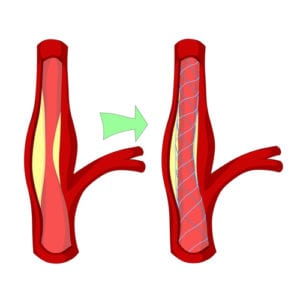Carotid Angiography and Stenting
 A minimally invasive procedure called carotid stenting, or carotid angiography, works to specifically identify and relieve any blockage or stenosis (narrowing) of the carotid arteries. The carotid artery is known as one of the most common areas to develop cholesterol buildup (or atherosclerosis), which is the hardening of the arteries. Development of atherosclerosis within the carotid artery is dangerous, and must be addressed in order to prevent a stroke. The carotid stenting procedure has been in practice since the 1970s, with only slight modifications to the types of stents used in the process.
A minimally invasive procedure called carotid stenting, or carotid angiography, works to specifically identify and relieve any blockage or stenosis (narrowing) of the carotid arteries. The carotid artery is known as one of the most common areas to develop cholesterol buildup (or atherosclerosis), which is the hardening of the arteries. Development of atherosclerosis within the carotid artery is dangerous, and must be addressed in order to prevent a stroke. The carotid stenting procedure has been in practice since the 1970s, with only slight modifications to the types of stents used in the process.
Carotid Ultrasound Will Detect Blockage
An ultrasound exam will let Dr. Ginkel know if the carotid arteries, located on the left and right sides of the neck, are developing stenosis from atherosclerosis. At this time, there are a few ways Dr. Ginkel can approach this issue, but if the blockage within your carotid is advanced, then either a stent or carotid endarterectomy will be recommended.
Carotid Artery Stenting to Improve Blood Flow
Stenting is a procedure that opens a narrowed artery blocked by cholesterol or thrombus – a mass of fibrin protein that occurs after trauma to the artery. As the artery becomes narrowed, blood has difficulty getting through to the head and neck. A stent is a mesh-like material that pushes the blockage out of the way, thus restoring normal blood flow.
How Dr. Ginkel Performs Carotid Stenting
At Midcoast Cardiovascular, Dr. Ginkel can implant a carotid stent to relieve occluded arteries using a minimally invasive procedure. Carotid stenting is usually performed at the hospital, in our cath lab, where you will lay flat on the treatment table while Dr. Ginkel injects a local anesthetic into your groin. Once the area is thoroughly numbed, Dr. Ginkel makes a small incision for the catheter, in order to conduct an ultrasound mapping of the femoral artery and the pathway.
Dr. Ginkel will thread a thin, straw-like catheter through the femoral artery and up into the affected carotid artery. The catheter will then expand a tiny balloon and mesh stent that are tacked onto the tip of the device. As the balloon expands, so does the stent, and once the stent is in place, we remove the balloon and catheter from the body. You will need to lay flat for about three to four hours following the procedure to make sure there is no bleeding at the opening of the femoral artery. Dr. Ginkel will cover the entry point with a compression bandage, and you will be ready to go home that day.
To find out more about our carotid stenting procedure and to schedule your carotid ultrasound, call Midcoast Cardiovascular today at 805-354-0112.
Recent Comments